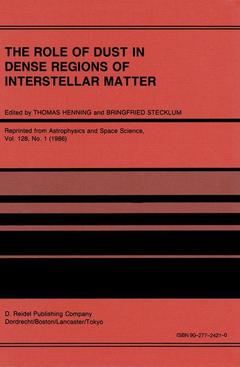Description
The Role of Dust in Dense Regions of Interstellar Matter, 1986
Proceedings of the Jena Workshop, held in Georgenthal, G.D.R., March 10–14, 1986
Coordinators: Henning Thomas, Stecklum Bringfried
Language: English
Publication date: 03-2012
266 p. · 16x24 cm · Paperback
266 p. · 16x24 cm · Paperback
Description
/li>Contents
/li>
TH. HENNING and B. STECKLUM University Observatory. Jena This workshop was organized by the University Observatory Jena and devoted to the physics and chemistry of dense regions of interstellar matter. It was especially dealing with the properties of interstellar dust grains and star formation in those regions. This field of research was opened in Jena already in the 1950s and an early fA U Colloquium on the topic of interstellar matter was held here in 1969. Since that time, the subject of interstellar matter has grown into a much more important part of astrophysics than it was in 1969. Now we are beginning to understand the process of star formation in a greater detail. The discovery of many interstellar molecules by radioastronomers opened the new field of interstellar chemistry. In addition, the application of the new techniques of infrared astronomy led to the discovery of several absorption bands, e. g. , the 3. 1 11m ice band, which pointed to the existence of grain mantles. More recently, the detection of infrared emission lines was the first hint to the existence of a new component of interstellar matter. All these things were discussed extensively during the workshop. The very successful IRAS mission, which was also a subject of this workshop, gave us many new insights and unexpected findings, e. g. , the detection of infrared cirrus clouds.
Preface.- I: Basic Observational and Laboratory Data of Dust Properties.- Dust Models Confronted with Observations.- The Role of Grains in Molecular Chemical Evolution.- Interstellar Gas Depletion and Dust Parameters.- On the Geometrical Cross-Section of an N-Mer.- Experimental Investigations of Astronomically Important Interstellar Silicates.- Problems with the Interpretation of the 220 nm Interstellar Feature.- Observations of the Very Broad-Band Structure by Combined uvby and UBV Photometry.- Carbon Molecules as Possible Carrier of the Diffuse Interstellar Bands.- Astrophysical Influences on the Diffuse Interstellar Lines.- II: Properties of Dense Clouds and Circumstellar Dust Shells.- Submm/Farinfrared Observations of Cold and Warm Dust Clouds.- On the Dust and Gas Associated with Sharpless 252.- The RHO Ophiuchi Cloud — An Overview.- The Relation Between Molecular Clouds and Stellar Kinematics.- The IRAS Satellite — Some Remarks on the Data, Their Availability and their Usage in Leiden.- Circumstellar Dust Shells Around Very Young and Massive Stars.- III: Very Young Stellar Objects and Star Formation in Molecular Clouds.- Bipolar Nebulae and Jets from Young Stars: Contributions from Calar Alto.- BN Objects — A Class of Very Young and Massive Stars.- Centers of Activity in Dust Clouds.- The Simulation of the Initial Mass Function and Star Formation Efficiency.- Self-Regulated Star Formation and Evolution of Stellar Systems.- The Past Star Formation Rate and the Initial Mass-Function in the Solar Neighbourhood.- Concluding Remarks.
© 2024 LAVOISIER S.A.S.
These books may interest you

The Physics of Interstellar Dust 83.43 €



